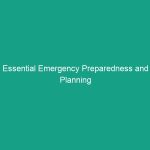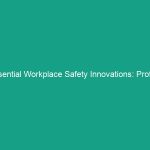Introduction
Good morning team,
Today, we’re going to talk about an important topic that affects our Safety during the colder months: the Wind Chill Index. Understanding this index is crucial for all of us who work outdoors or in unheated environments. As temperatures drop, the risk of cold exposure increases, and it’s essential to know how to protect ourselves. Let’s dive into why these guidelines are vital for our health and Safety.
Understanding the Wind Chill Index
The Wind Chill Index is a measure that combines air temperature and wind speed to determine how cold it feels outside. It’s important to note that the Wind Chill Index is not the actual temperature but rather how our bodies perceive the chill. For example, when the temperature is 30°F but the wind is blowing at 20 mph, it can feel like 12°F. Understanding this concept is critical for protecting ourselves from the harsh Effects of cold weather.
Many employees believe that as long as the temperature is above freezing, they are safe from cold-related risks. However, this is a misconception. Even temperatures above 32°F can pose serious health risks if wind speeds are high, leading to increased chances of frostbite and hypothermia.
Key Hazards, Risks, and Safety Considerations
Working in cold weather can expose us to several Hazards, including:
- Frostbite: This occurs when skin and underlying tissues freeze, often affecting fingers, toes, ears, and the nose.
- Hypothermia: A life-threatening condition that occurs when body temperature drops below 95°F, leading to confusion, drowsiness, and potentially fatal consequences.
- Decreased dexterity: Cold temperatures can impact our ability to perform tasks effectively, increasing the risk of accidents.
- Reduced awareness: Cold weather can impair our judgment and reaction times, making it harder to respond to hazards.
Ignoring these risks can have serious real-world consequences, including injuries and increased healthcare costs. It’s essential to recognize these hazards and take proactive measures to mitigate them.
Best Practices, Procedures, & Actionable Advice
To protect ourselves from the dangers associated with the Wind Chill Index, here are some Best Practices to follow:
1. Check the Wind Chill Index Regularly
Before heading to work, check weather reports for the Wind Chill Index. This simple step can help you prepare adequately for the conditions you will face.
2. Dress Appropriately
Wearing the right clothing is crucial to staying warm and safe. Follow these guidelines:
- Layering: Wear multiple layers of clothing. Start with a moisture-wicking base layer, add an insulating layer, and finish with a waterproof and windproof outer layer.
- Protect Extremities: Wear insulated gloves, hats, and scarves to protect your hands, head, and neck.
- Footwear: Ensure your boots are insulated and waterproof to keep your feet warm and dry.
3. Take Breaks and Stay Hydrated
When working in cold conditions, it’s important to take regular breaks in a warm area. This allows your body to recover from the cold. Also, staying hydrated is essential as hydration helps maintain body temperature. Drink warm, non-caffeinated beverages whenever possible.
4. Monitor Your Body
Pay attention to your body’s signals. If you start to feel cold, numb, or experience shivering, it’s time to take action. Recognizing the early signs of frostbite or hypothermia can make a significant difference.
5. Use the Buddy System
Whenever possible, work with a buddy. Having someone else around can increase safety awareness and ensure that help is readily available if needed.
Regulations, Standards, and Compliance
It’s important to remember that OSHA (Occupational Safety and Health Administration) has Regulations in place to protect workers from extreme weather conditions, including cold exposure. Compliance with these Standards not only helps protect employees but also ensures that the company maintains a safe working Environment.
Familiarize yourself with our company-specific safety protocols regarding cold weather work. Understanding these regulations will help keep you and your coworkers safe.
Employee Engagement & Discussion
Now that we’ve covered the essentials of the Wind Chill Index and the associated risks, let’s open the floor for discussion. What safety challenges have you encountered related to working in cold weather? Have you ever experienced frostbite or hypothermia? Sharing these experiences can help us all learn and develop better safety practices.
Conclusion & Key Takeaways
In conclusion, understanding the Wind Chill Index and its implications is crucial for our safety during colder months. Remember to:
- Check the Wind Chill Index before working outdoors.
- Dress in layers and protect your extremities.
- Take breaks in warm areas and stay hydrated.
- Monitor your body for signs of cold stress.
- Work with a buddy to enhance safety.
By applying these practices, we can significantly reduce the risks associated with cold weather. Thank you for your attention and commitment to safety. Together, we can create a safer workplace for everyone!


